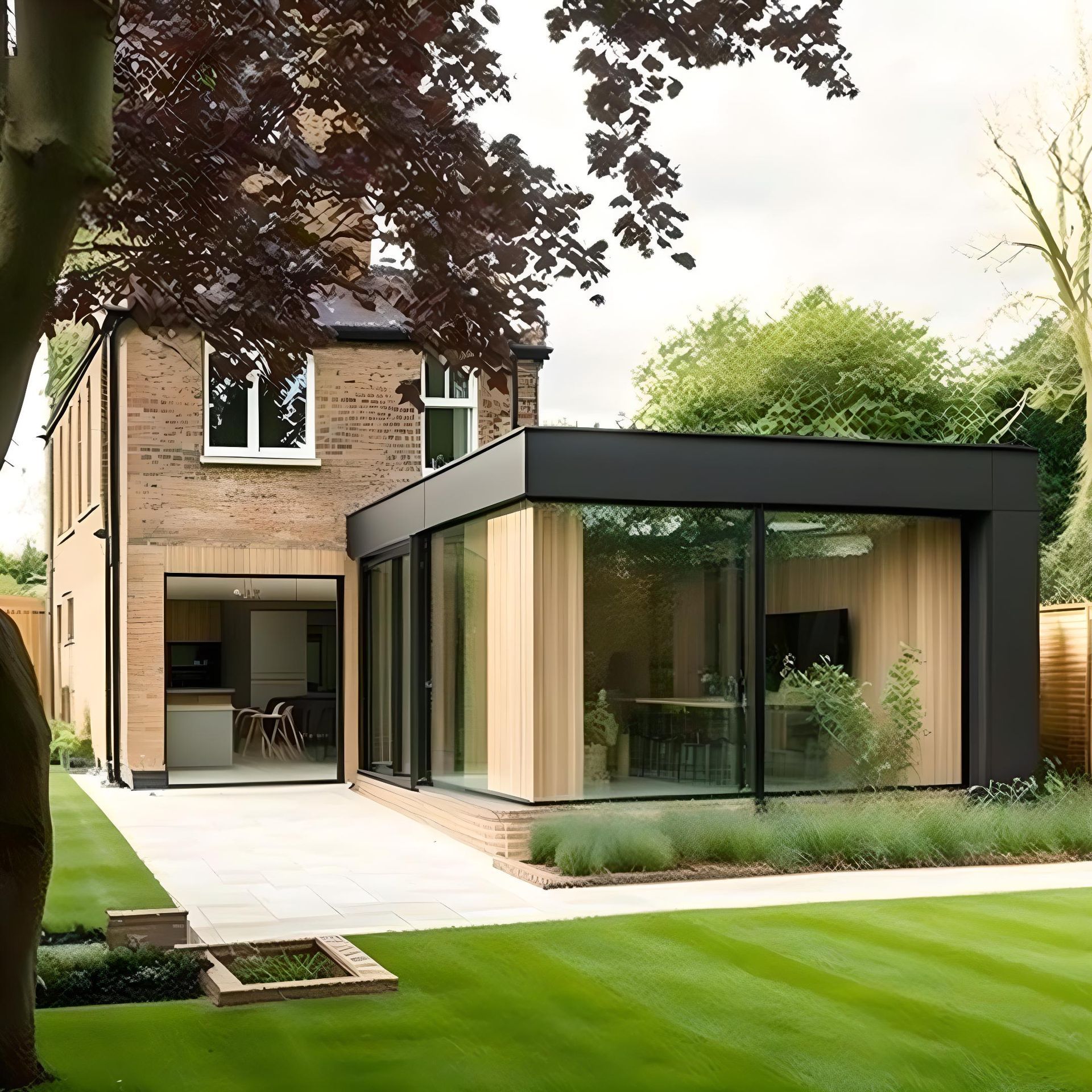How to Increase and Control Natural Light
If you’re planning a house extension or home renovation project, you’ll need to consider how you’ll introduce natural light into the home.
Increasing and controlling natural light is an excellent way to make a space feel more inviting, reduce energy costs, and improve overall health and well-being.
Natural light can also add value to a home and illuminates design features, colour usages, ornaments, decor and furniture.
Here are some tips for improving the natural light in your home.
Why natural light matters
1: Natural light improves wellbeing
Most people could do with more natural light, especially in winter. In fact, some 1 in 6 adults and 20% of children are deficient in Vitamin D in the UK and around half would benefit from more Vitamin D.
Letting natural light enter the home is a great way of boosting Vitamin D. This is particularly important in winter or for those who work from home.
2: Natural light reduces energy costs
It stands to reason that natural light reduces reliance on synthetic lighting. By allowing natural light into your home, you’ll reduce energy bills and your carbon footprint.
3: Natural light makes rooms feel bigger
It’s well known that natural light makes rooms larger and airier. Natural light is a great way to open up smaller rooms, expand confined spaces, and make larger rooms look even grander.
4: Natural light brings out colours
Light’s reflective qualities bring out colours and other aesthetic features, which makes rooms look more visually appealing.
Tips for increasing natural light
Natural light is free once you design your room/project to accentuate natural light sources and not detract from them. Here’s how to increase natural light in your house extension or loft conversion:
1: Install larger windows
Installing larger windows is the most effective way to introduce natural light into the home. Large windows increase home value and allow natural light to flood interiors. Investing in high-quality windows may seem pricey compared to other, more exciting options, but you won’t regret it.
2: Consider blinds
Heavy curtains can be cosy, but they can block a lot of light and cover the edges or top of the windows. Blinds are more efficient at blocking light and letting it in, and their lightweight appearance contrasts to thick curtains.
3: Add skylights
Skylight windows are a superb way of brightening up rooms while adding an impactful element that differentiates the space. They’re perfect for day and night - great for star and moongazing when fitted in upstairs bedrooms and loft conversions!
4: Add mirrors
Placing mirrors around a room can help to reflect light, making a room seem brighter and more spacious.
5: Paint walls a light colour
Dark colours can make a room feel darker, so painting walls a light colour like white or cream can help to reflect light and make a room brighter.
This is a tried and tested method of brightening up a room and works especially well for a bright room with large windows. White rooms with tall sash windows are the hallmark of Parisian design.
6: Solar tubes
Solar tubes are a great way to bring in natural light when installing larger windows isn’t an option, e.g. in an enclosed interior room.
Solar tubes use highly reflective materials to ‘capture’ light from outside and reflect it inside via a tube. They’re becoming increasingly popular in the UK and reducing reliance on synthetic lighting, lowering electricity bills and boosting a home’s eco-friendly credentials.
7: Glass walls and ceilings
Some extensions, like rear or side-return extensions, are perfect candidates for glass walls and ceilings. In addition, specialist blinds and sun blockers can be installed to keep glass-walled rooms cool in hot summer months.
8: Bifold or sliding doors
Adding bifold or sliding doors to a rear extension is an excellent way of brightening up the entire ground floor. If you’re creating an open-plan space, it’s crucial to consider how you’ll keep it well-lit, and large doors are an excellent way to do that.
Designing your extension to boost natural light
Designing an extension to boost natural light is an essential factor when designing a practically useful and aesthetically pleasing space.
The benefits of walking into a bright, well-lit home when the sun is shining can’t be underestimated. On the contrary, dull or dimly lit spaces just aren’t as welcoming and take some of the gloss or emphasis away from other design elements.
Natural light also has many health benefits, from improving mood to aiding in better sleep. By incorporating natural light into an extension, you can experience these benefits while also increasing the value of your home.
Consider the orientation of the extension
When weighing up different types of extensions, consider the extension's orientation relative to the house and sun.
If possible, position the extension to face the direction that will receive the most sunlight. For example, if you have a side return that doubles up as a superb sun trap, that might be an excellent candidate for a skylight window, solar tube or glass ceiling.
The size of the extension also matters, as smaller spaces are generally darker, while large spaces can suffer from glare. If you’re building an open-plan space, consider adding interior partitions or screens to protect seating positions from excessive glare.
Choosing the right materials
The materials that are used to construct the extension also influence lighting qualities.
The more glass you install, the brighter the room will be. However, if you’re using a lot of glass, it’s probably worth investing in quality triple-glazed glass that retains heat. Underfloor heating can also be a massive advantage.
Consider the placement of furniture and other items that can block natural light. You might want to block light from some angles, e.g. to reduce glare on TV and work areas.
By choosing light-coloured furniture and fabrics, you can effectively reflect light. Darker materials will absorb light.
Accessories for natural light
Soft but clean furnishings, reflective ornaments, mirrors and plants all freshen up interior spaces. You can also use plants to shield areas from glare without heavy furniture or partitions.
Intelligently positioning design elements will help you balance the light and the dark for maximum impact!
How to reduce glare
Natural light is great - but what if it’s excessively bright?! This conundrum often applies to open-plan spaces with many windows, sliding doors, bi-folds, etc. Glass walls and ceilings also introduce unique challenges for controlling light and heat.
Reducing glare in an open-plan room can be a challenge, especially if the space has large windows. Glare can cause visual fatigue and can be a distraction, making it difficult to focus on work, the TV, etc.
Don’t worry - there are many creative ways to fix excessive glare without ruining your designs and ideas!
Here’s how to fix problematic glare without compromising the room:
1: Curtains and blinds:
Curtains or blinds can help to reduce the amount of light entering the room while still allowing the space to remain bright. You may also want to consider window films, which can be applied to the windows to reduce glare and UV radiation. Blinds with top openings or transition shades reduce excessive light while retaining total control over how well-lit the room is.
2: Artwork and wall hangings:
Another way to reduce glare in an open-plan room is to use artwork and wall hangings. Strategic placement of artwork and wall hangings can help to absorb and reflect light away from the room, thus reducing glare.
3: Mirrors:
Mirrors can be used to reduce glare by reflecting light
away
from the glary spots. Placing mirrors in strategic locations can help reduce glare while still allowing natural light to enter the space.
4: Get creative with partitions:
You can buy attractive partitions for open-plan rooms, such as bamboo screens. Bookshelves are another excellent choice, as are tall plants and large ornaments. Find creative ways to create shade where you need it.
5: Furniture arrangement: Furniture can also be used to reduce glare. Consider positioning furniture in front of windows to absorb some of the light or placing furniture in a way that reflects light away from the room. If you’ve got a specific furniture arrangement in mind, ensure you factor in glare - as it might derail your plans!
By evaluating the space and considering the best solutions for reducing glare, you can create a comfortable and productive environment that still benefits from plenty of natural light - the best of both worlds!
Summary: How to increase and control natural light
Natural light boosts a room’s practical and aesthetic credentials and should be a major consideration for any house extension, loft conversion or other home projects.
Be aware of how light will interact with your designs, including how you might clamp down on excessive glare without banishing light from a well-lit room.
Contact Fast Plans to design an attractive interior space that maximises natural light. We’ll work with you to make your house extension or loft conversion dreams become a reality!
Get in touch
It doesn't matter how large or small your project is, or how early in the planning process you are. We can help.
With our vast experience, we deliver both a refreshingly honest approach and great value for money; after all, when it comes to projects as crucial as these, you want to get it right the first time! Our team of experienced and highly qualified architects and designers can bring your home improvement dreams to life.
Request a FREE consultation with our design team
Request your FREE no-obligation proposal

Schedule a Call/Get in Touch Form
We will get back to you as soon as possible.
Please try again later.
Related posts
Our fast and seamless design and planning services have helped thousands of homeowners maximise their living space.
H: M - F / 8am - 5.30pm
Take a Look Around
Service Areas
Social
Fast Plans | All Rights Reserved.


